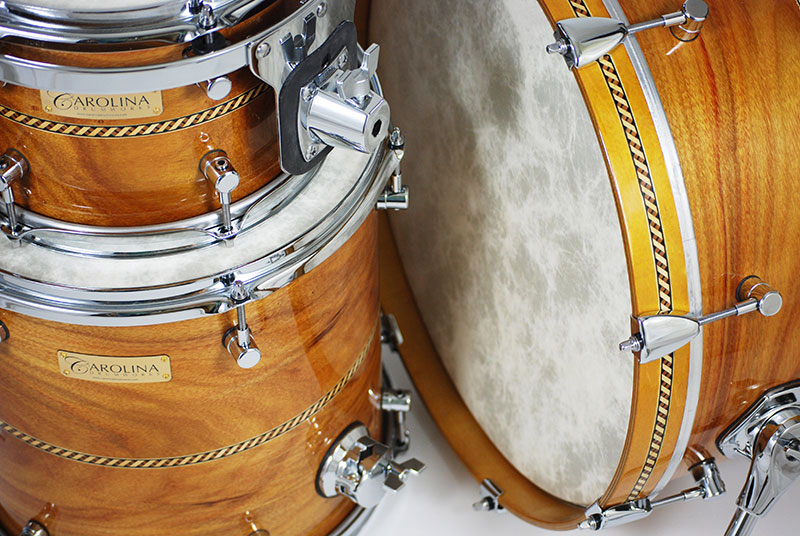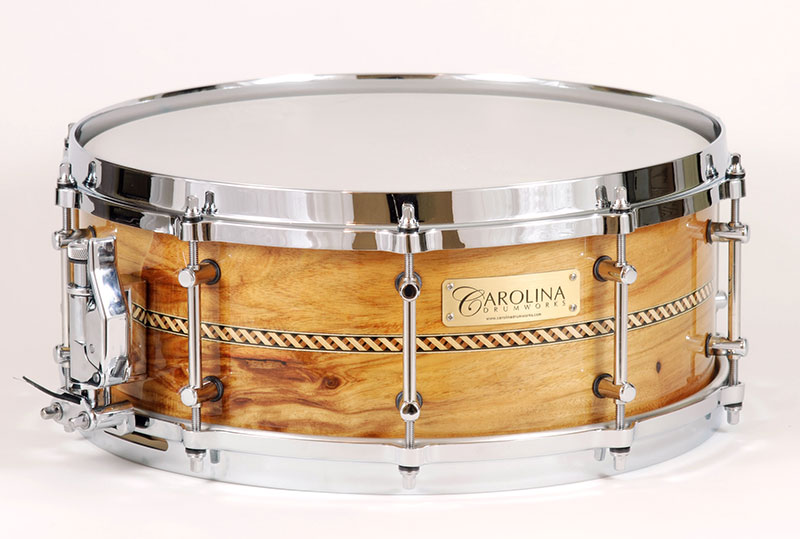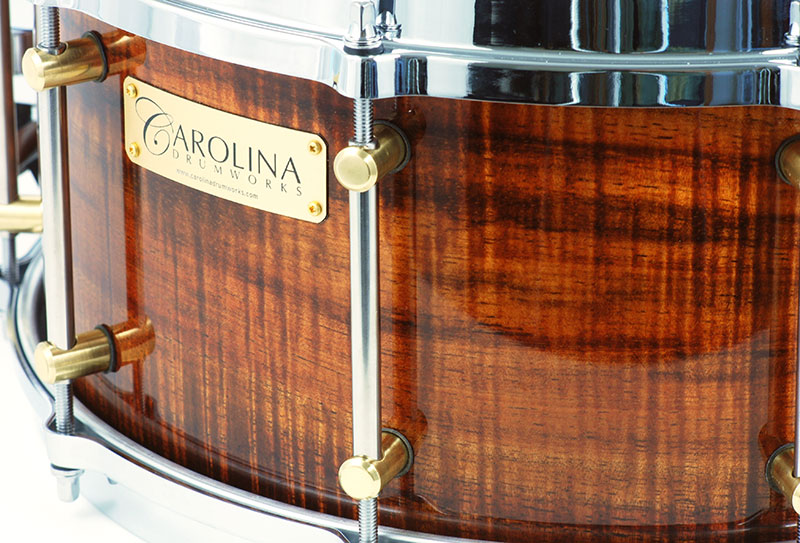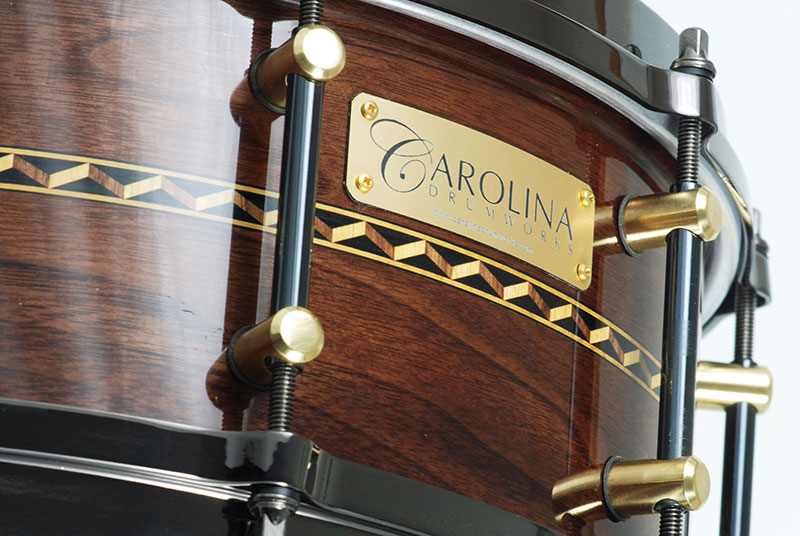Ritscher, drummer and drum builder from Osthofen sees himself as an "upcycler". He produces high-quality drums from old wood. He prefers to handle staves from old wine barrels.
Building a stave shell
Lathing (Photo by DrumShed member kerry8319
From 2009 until 2013 Rob Stapleton built the website, "P.D. Good's Builder's Manual", (www.pdgood/ drumshed) which is a compilation of searches on topics important to drum builders supplemented by correspondence and conversations with various manufacturers and individual drum builders, and excerpts from related forums, such as wood worker's and ecology forums. It is STILL the #1 result in a google search for 'how to build a drum'. Rob has graciously given us permission to republish from that wealth of information. He wanted us to acknowledge the now defunct sites drumshed.org and drumtown.info, and all the drum builders out there who contributed to this treasure trove of information.
Read moreIncluded with Your Custom Drum: Custom Advice
They say the Internet has changed everything.
On one hand, that’s a good thing. It gives us a ton of information we never had access to before. We’re way better informed than we used to be. But on the other hand maybe there are times when we’re actually over-informed – to the point of getting distracted from what we’re really trying to accomplish.
This may sound like I’m some kind of wet blanket telling kids to turn off the computer and go outside to play. But actually I’m wondering whether some drummers in the Information Age are getting distracted with how their drums are made instead of focusing on the art of playing them.
The more products we study and buy online, the more we find ourselves shopping for specifications instead of overall performance. We do it with electronic gear, household gadgets, tools and more – and we’re starting to do it with musical instruments like guitars and drums. But, if you think about it, most things that help express our personal style – clothing, furniture, food – we tend to choose not by specifications but by their overall performance: the look, the taste, the touch, the experience. And, honestly, what can help express your personal musical style as much as the instrument you play?
A few years ago, I was watching a top-ranked artist who had just finished a clinic at a major drum show. He was sitting in a drum builder’s booth checking out a snare, and the builder was explaining that the snare in question was a stave drum.
Blank look from the artist.
So the builder showed him the inside of the drum, pointing out the staves and explaining the advantages.
Another blank look from the artist.
It was like they were talking in two different languages, one the language of design specs and the other the language of performance. The architect and the homeowner, if you will. Watching them, I was reminded that, not so many years ago, drummers didn’t pay much attention to how a drum was made. They just played, and they wanted to play drums that sounded and felt good – musicians looking for the best musical instruments they could afford. Most of them didn’t know the difference between ply shells and solid shells. They had no idea what kinds of wood were being used, or how the edges were cut, or how much drop there was on the strainer, or where the vent was positioned – and they didn’t care. Play a top-level drum and it sang for you and it did everything you asked of it. What else mattered? “This one, man, this one’s got that sound!”
As a builder, I welcome discussion about edges, dimensions, materials, tuning techniques and so on, because this stuff fascinates me. And it’s good that players want to talk about these things. Like most of my drum-building colleagues, I like having informed customers. It helps them appreciate the value of owning a custom or boutique instrument.
But today, by way of blog articles, discussion forums, how-to videos and advertising, the science of drum design has gone public. Maybe even a little too much.
Think about this: Should you order a custom made suit and specify what kind of stitching to use? Or visit the restaurant kitchen to tell the chef how you want the seasonings measured in your entrée?
Take a double 45 bearing edge profile, for example. You might shop for that because you’ve heard that a double 45 edge is a good thing – but you may not really know how it works, or what alternatives you should consider. (Want to really get technical? On that double 45, where is the apex positioned, and how wide is it? Is there any roundover, and if so how much? How is the edge smoothed and finished? Those kinds of details make a difference in how that double 45 functions. Trust me, to a knowledgeable builder the phrase “double 45” is a starting place, not the real spec.)
Whoa. TMI alert! Let’s back up a second.
You may have heard about synergy – the concept that the whole is greater than the sum of its parts. Synergy is an important aspect of drum design. There are literally dozens of design choices that influence the sound and character of a drum. Individually, most of these choices have very small effects on the overall sound. But taken together, they can reinforce one another, working together to make the drum as a whole perform the way you want– or each can cancel another one out, losing the advantages altogether. Unfortunately, most online information addresses these factors individually, not in terms of how they work together. So you can easily get caught up in specifications, and find yourself shopping for a set of specs instead of for what the drum does for you – focusing on the trees and losing sight of the forest.
Let’s try a better starting point. Tell me your destination, not your route to get there.
How will you use the drum? What type of music? What type of room? What playing style? What sort of voice should it have? Where would it fit into the rest of your drum arsenal? How should it feel to play?
Here are the kinds of information that help me as a builder: “I need a bright sound.” “Looking for power.” “I want it real responsive for ghostnotes.” “Something beefy.” “I do a lot of cross-sticking.” “I tune very tight.” “I like a lot of ring.” “I play mostly small clubs.”
My advice? Find a builder who knows his craft and talk to him. Open up about what you’re trying to achieve; put your goals together with his solutions. Sure, go ahead and ask about specs, and keep asking until you understand what makes your instrument tick. By all means, be an informed consumer. But don’t feel that you have to make all the technical design decisions before turning them over to the builder, or that you need to become an expert yourself in order to make good choices. Instead, tap into his experience and knowledge base and use them to your advantage.
Then turn off your computer and go out and play…drums.





